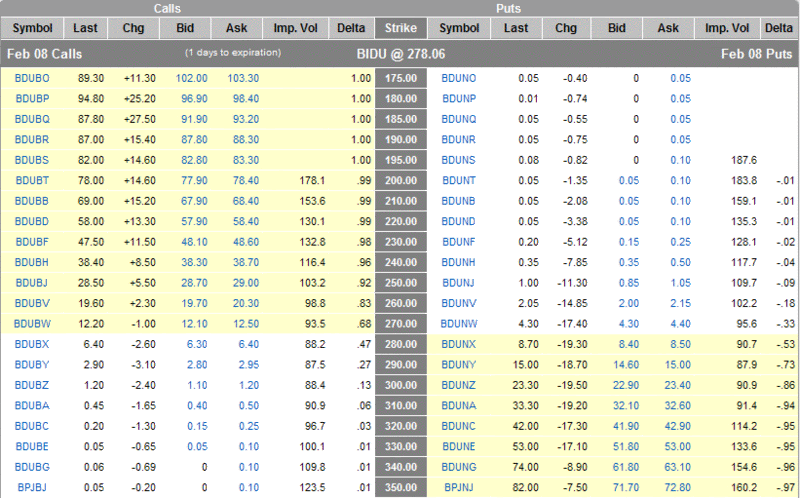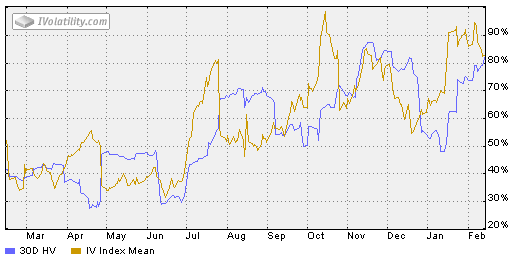BIDU, Calls and Time Decay
I am generally not a fan of being long any options during options expiration week, as the effort required to ‘salmon’ upstream against the relentless current of time decay (theta) makes these trades extremely challenging. Not only do you have to get the direction right, but you have to do it in a big way and in a hurry. Of course, if there is another volatility event that you have to overcome during options expiration week, that makes the task even more difficult.
Baidu (BIDU) is a perfect case in point. Earnings came out after the close last night and while the most recent quarter comfortably exceeded expectations, the company’s tepid guidance had some analysts wondering what the future revenue stream looks like.
With the conflicting numbers and multiple interpretations available, the market action has been interesting to watch. After closing at 261.09 yesterday, BIDU traded up almost 30 points in the after hours session last night, before settling back to an after hours gain of about 18 points. In pre-market the stock gradually slid down to 274, up about 13 points over Wednesday’s close. When the regular session opened, the stock fell quickly to 263, recovered sharply to trade briefly above 280, and has been in a downtrend ever since, currently trading back down to about 267.
The first graphic, which comes from optionsXpress, shows how the options were behaving after about a half hour of trading, when BIDU was up 16.97 at 278.06. If you happened to be long BIDU calls at a strike of 270 or above, you were losing money, even with the stock up 6.5%.
Normally, one would expect a post-earnings volatility crush, where IV contracts and all options lose their value, but as the iVolatility chart on the bottom shows, IV was not particularly high (relative to recent historical BIDU levels) coming into earnings, nor did it drop dramatically after earnings were out (see the IV numbers in the optionsXpress table.)
BIDU’s action today is an excellent illustration of what happens toward the end of the options expiration cycle, when time decay accelerates. While it is still possible to make money being long options, the percentages are with those who are on the side of time decay. If you are looking at a stock with high IV and an earnings report or other volatility event, consider that at the money options can still be losers even if you get the direction correct and have a 6.5% move in the underlying on your side.




3 comments:
Oh, to have sold an ATM straddle (hedged, of course) before the close yesterday... I remember some discussion during the ToS weekly chat that they were going for around $30+ -- with BIDU's price now back down to yesterday's levels, you could buy back the straddle for $12.50 or so.
Of course, the cost of the hedge (long strangle) probably would've been too high for a profitable trade (net), as its value also would be hit by time decay and IV crush.
I wonder whether some clever monkey at a hedge fund sold BIDU after earnings IN THE CHINESE STOCK MARKET (during our after-hours market), and bought back shares today on the NASDAQ. The prevalence of high-flying Chinese stocks cross-listed here and in China could permit some interesting arbitrage trading.
But all such fantasies aside, that BIDU could not sustain its after-hours market gains (it's up presently less than 1%) is a bit troubling, not just for the stock itself, but to the extent that it is a NASDAQ leader, the overall market. otoh, the $COMP is down over 32 right now, so perhaps the fact that BIDU's able to rise despite the market direction today will be seen as a sign of strength.
Felix aka thenakedtrader
The BIDU calls did experience a volatility crush between the close of trading on February 13th and the close of trading on February 14th. BIDU's earnings were announced before the opening of trading on February 14th. Examples of the implied volatility for near-the-money BIDU February options are outlined below.
The BIDU Feb 260 call had a I.V. of 223 and the BIDU Feb 260 put had a I.V. of 221.7 at the close of trading on February 13th. The implied volatility of these calls decreased to 79.0 for the Feb 260 call and to 53.7 for the Feb 260 put by the close of trading on February 14th.
Your closing statement of "If you are looking at a stock with high IV and an earnings report or other volatility event, consider that at the money options can still be losers even if you get the direction correct and have a 6.5% move in the underlying on your side" is very accurate for the BIDU February 14th earnings announcement.
One trade that Tom Sosnoff mentioned during ToS chat on Wednesday (after hours) was to have bought the 250/260 call spread, which was available at $5.50 or so for most of the day.
Given that BIDU was trading above 260, it's a great example of how a corporate event during expiration week can offer 'deals' (provided you get the direction right!), and why you want to use spreads when IVs are inflated and going to get crushed during the next session (i.e. offset the extrinsic value of the option you're buying with the extrinsic value of the option you're selling).
tnt
Post a Comment